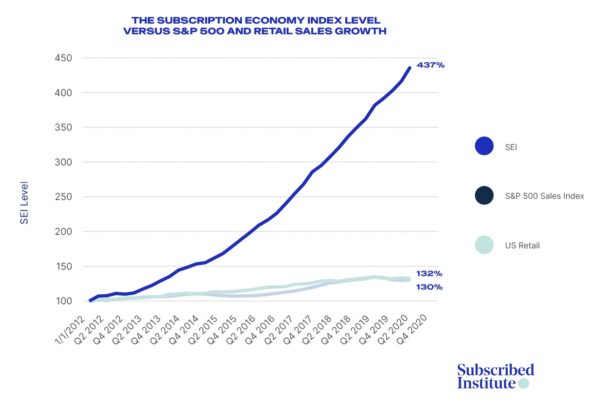In the last nine years, the subscription space grew at an unprecedented pace, and the numbers speak for themselves. Zuora, a Software-as-a-Service (SaaS) platform providing businesses the resources needed to launch and manage subscription-based services, released its bi-annual Subscription Economy Index (SEI). Subscription businesses saw a 437% increase in revenue growth since Q1 2012, according to the report.

Subscription companies have grown five to eight times faster than traditional businesses, according to the SEI. Last year, the revenue growth rate almost hit 12%, while the revenues of product-based businesses dropped by nearly 2%. Industries like SaaS, telecommunications and publishing reached all-time highs since the start of their subscription business models.
An increasing number of people are subscribing to services that best fit their needs and evolving lifestyles. The revenue per subscription account surpassed the 2019 rate by 4% in 2020. The subscription industry is officially outpacing product-based companies, and the rapidly changing consumer behaviors are the main contributor to this shift.
Consumers are Shifting Away from Ownership, Leaning Toward Subscription
Ownership fatigue is a major factor in the rise of subscriptions, according to Zuora’s End of Ownership survey, because they tend to relieve consumers of the burden that can come with material goods. Transitioning to a subscription model for products like software and media can result in greater flexibility and access to more desirable experiences for consumers.
Last year, 78% of international adults had some form of subscription service, a 7% increase from 2018, the SEI report states. Consumer-centric strategies and solutions are another key contributors to these rising numbers. The increase in the demand for subscription services is enticing businesses across multiple industries to adapt to this model.
In 2020, SaaS showed an average revenue growth of 18%. The sector’s ability to quickly respond to customer feedback and implement it helped generate revenue at a time when people rely on technology more than ever. Consumers aren’t owning an actual software — they want a platform to provide it and quickly adapt to their needs.

The coronavirus pandemic forced people to stay home and work remotely. It also prevented people from traveling, causing business and staff meetings to go online. Telecommunication companies provided remote workers with the collaborative tools they needed to stay connected. Zoom, the video-conferencing app, reported 56,000 daily downloads in January 2020. It reported more than 2.1 million daily downloads two months later, when the pandemic became a global health crisis. These shifts in consumer needs resulted in an average revenue growth of 10% in subscription telecommunications companies.
The SEI survey reported on many benefits for a consumer as they consider becoming a subscriber. Convenience, cost-effectiveness and variety are at the top of the list. Consumers have come to expect the timely availability and convenience of goods and services. For example, people are subscribing to news worth paying for. The adaptation to a subscription business model helped the publishing industry deal with its ad-revenue struggles, bumping the overall revenue up by 16%.
“The time is now for companies to embrace the subscription business model,” Amy Konary, Founder and Chair of the Subscribed Institute at Zuora, told Business Wire. “Our bi-annual Subscription Economy Index suggests that brands can increase value to their customers through the ongoing delivery of services when and where they’re needed.”
Key Takeaways:
- Subscription businesses saw a 437% increase in revenue growth since Q1 2012.
- This growth is due to the shift in consumer lifestyle trends, which include convenience and cost savings.
- Consumers are transitioning from ownership to usership, with 78% of international adults using some form of subscription service.

